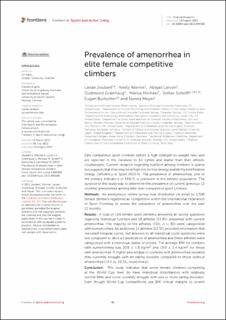| dc.contributor.author | Joubert, Lanae | |
| dc.contributor.author | Warme, Amity | |
| dc.contributor.author | Larson, Abigail | |
| dc.contributor.author | Grønhaug, Gudmund | |
| dc.contributor.author | Michael, Marisa | |
| dc.contributor.author | Schöffl, Volker | |
| dc.contributor.author | Burtscher, Eugen | |
| dc.contributor.author | Meyer, Nanna | |
| dc.date.accessioned | 2023-03-01T14:25:44Z | |
| dc.date.available | 2023-03-01T14:25:44Z | |
| dc.date.created | 2022-10-19T11:55:56Z | |
| dc.date.issued | 2022 | |
| dc.identifier.citation | Frontiers in Sports and Active Living. 2022, 4:895588. | en_US |
| dc.identifier.issn | 2624-9367 | |
| dc.identifier.uri | https://hdl.handle.net/11250/3055073 | |
| dc.description.abstract | Elite competitive sport climbers exhibit a high strength-to-weight ratio and are reported in the literature to be lighter and leaner than their athletic counterparts. Current research regarding nutrition among climbers is sparse but suggests that they may be at high risk for low energy availability and Relative Energy Deficiency in Sport (RED-S). The prevalence of amenorrhea, one of the primary indicators of RED-S, is unknown in this athletic population. The purpose of this study was to determine the prevalence of current (previous 12 months) amenorrhea among elite level competitive sport climbers.
Methods: An anonymous online survey was distributed via email to 1,500 female climbers registered as competitors within the International Federation of Sport Climbing to assess the prevalence of amenorrhea over the past 12 months.
Results: A total of 114 female sport climbers answered all survey questions regarding menstrual function and 18 athletes (15.8%) presented with current amenorrhea. The majority of the athletes (72%; n = 82) were categorized with eumenorrhea. An additional 14 athletes (12.3%) provided information that indicated irregular cycles, but answers to all menstrual cycle questions were not congruent to elicit a classification of amenorrhea and these athletes were categorized with a menstrual status of unsure. The average BMI for climbers with eumenorrhea was 20.8 ± 1.8 kg/m2 and 19.9 ± 2.4 kg/m2 for those with amenorrhea. A higher percentage of climbers with amenorrhea revealed they currently struggle with an eating disorder compared to those without amenorrhea (13.5 vs. 22.2%, respectively).
Conclusion: This study indicates that some female climbers competing at the World Cup level do have menstrual disturbances with relatively normal BMIs and some currently struggle with one or more eating disorders. Even though World Cup competitions use BMI critical margins to screen competitors, this research highlights the need for more medical supervision of competitive elite female sport climbers in order to protect their overall health, including menstrual function. Further research is required to clarify how many climbers suffer from endocrine abnormalities related to RED-S. With more scientific evidence in this area practitioners will be better equipped to educate the athlete and coach with evidence-based nutrition recommendations. | en_US |
| dc.language.iso | eng | en_US |
| dc.publisher | Frontiers Media | en_US |
| dc.rights | Navngivelse 4.0 Internasjonal | * |
| dc.rights.uri | http://creativecommons.org/licenses/by/4.0/deed.no | * |
| dc.title | Prevalence of amenorrhea in elite female competitive climbers | en_US |
| dc.type | Peer reviewed | en_US |
| dc.type | Journal article | en_US |
| dc.description.version | publishedVersion | en_US |
| dc.rights.holder | © 2022 Joubert, Warme, Larson, Grønhaug, Michael, Schöffl, Burtscher and Meyer. | en_US |
| dc.source.pagenumber | 12 | en_US |
| dc.source.volume | 4 | en_US |
| dc.source.journal | Frontiers in Sports and Active Living | en_US |
| dc.identifier.doi | 10.3389/fspor.2022.895588 | |
| dc.identifier.cristin | 2062722 | |
| dc.source.articlenumber | 895588 | en_US |
| cristin.ispublished | true | |
| cristin.fulltext | original | |
| cristin.qualitycode | 1 | |

